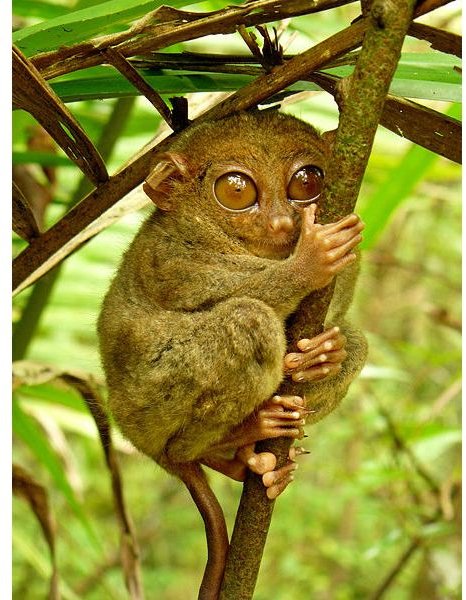About the Philippine Tarsier, World's Smallest Monkey & Endangered Species
The Philippine Tarsier
The Philippine tarsier, Tarsius syrichta, is an endemic species of primate found only in the Philippine islands of Bohol, Samar, Leyte, and Mindanao. It is popularly known as the “world’s smallest monkey” for its physical similarities with the lemur, loris, and tree shrew. However, taxonomists say that the Philippine tarsier is not a monkey but belong to a more primitive suborder of Order Primata: the prosimians or Prosimii. Fossil evidence shows that the Philippine tarsier is 45 million years old and among the oldest surviving land animal species in the Philippines dating back to the Eocene period. Its relatives were identified in the neighboring islands of the Philippines: Borneo, Sumatra, and Sulawesi, Indonesia.
The curiosity of people and scientists to the Philippine tarsier is intense because of its unique characteristics and habits. The tarsier’s body is covered with gray fur except the tail which is nearly naked. It is an extremely small primate with a head and body length measuring 118-149 mm (about the size of the hand). It only weighs 113-142 grams. The male is larger than the female. The tail which has tuft of hair at its end is longer (232 mm) than the animal’s body. Like the owl, the tarsier has a joint between its skull and spine that allows the head to move in a 180-degree arc. The tarsier’s eyes are highly noticeable because of their enormous size. In terms of volume, the tarsier’s eye orbits are larger than that of the brain case and the stomach. The animal has very long ankle bones (where the word Tarsius was derived) and lowers limbs twice as long as the trunk.
The large eyes of the Philippine tarsier are an adaptation to a nocturnal life. During the night, they hunt animal preys such as crickets, cockroaches, lizards, birds, and bats. They are found clinging in tree branches or hiding in tree holes during the day but they descend to the ground at night to hunt. They communicate by sound production and release of pheromones. They are extremely shy and avoid close encounters to humans.
Philippine Tarsier Causes of Endangerment
The majority of Philippine tarsiers are found in the island of Bohol. People in the island province recounted that during the 1960’s there are thousands of tarsier thriving in Bohol forests but today there are only few hundreds of them.
The introduction of alley cats in Bohol forests is believed to be a major cause in the decline of tarsier population. Cats hunt tarsiers because these primates have close resemblance to rats.
Habitat destruction is another cause of the decreasing number of tarsiers in the Philippines. Deforestation through logging and slash-and-burn farming has made tarsiers homeless. The forest is the only place where they can find a place to sleep, a place to hunt their food, and a place to reproduce. The tarsiers’ survival depends on the forest.
Tarsiers have been collected for the pet trade. In the past, they were cheaply sold at a retail price of less than 20 USD each. Now that the animal is rare, the retail price is higher. They cannot be kept as pets because they are extremely vulnerable to stress caused by the presence of humans and discomfort to their new homes (cages). Tarsiers die if they cannot cope up with stress. Some stressed tarsiers even commit suicide by bashing their heads. A tarsier expert said that tarsiers cannot live long when in captivity.
The dwindling population of Philippine tarsiers can also be attributed to people’s ignorance on the contribution of tarsiers to biodiversity. They are important part of the forest food chain and their disappearance can cause a negative impact to forest ecosystem.
Conservation of the Philippine Tarsier
The Philippine tarsier is listed in Appendix II of the Convention on International Trade of Endangered Species (CITES) to carefully monitor the international trade of the species.
By virtue of Proclamation 1030 by President Fidel V. Ramos, the Philippine tarsier was declared as a specially protected faunal species of the Philippines. The proclamation prohibits the “hunting, killing, wounding, taking away or possession of the Philippine tarsier and the conduct of activities destructive to its habitat”.
The Philippine Tarsier Foundation, Inc. (PTFI) was established to implement the Philippine Tarsier Conservation program. It is a non-stock and non-profit organization but receives support from the Department of Environment and Natural Resources (DENR) and the Department of Tourism (DOT). The foundation maintains a protected sanctuary of tarsiers in Corella, Bohol. Because the Philippine tarsier received “Data Deficient” and “Conservation Dependent” status from the International Union for the Conservation of Nature (IUCN), the foundation is spearheading various researches on the biology and ecology of the tarsier. The foundation is also educating the community on the importance of tarsier to biodiversity. Furthermore, the tarsier sanctuary is promoted for eco-tourism to educate more people on the value of the primate and also to generate funds for the various projects of PTFI.
References
The Philippine Tarsier Foundation, Inc. Website
Picture of the Philippine Tarsier
This post is part of the series: Philippine Endangered Animal Species
The Philippines is a biodiversity hot spot. Many of its endemic species are disappearing rapidly due to human activities. This series of articles provides information on Philippine endangered animal species. What are the conservation efforts directed to these animals?
